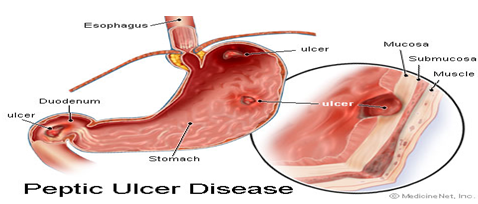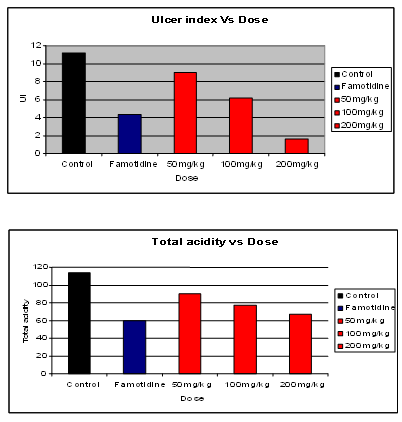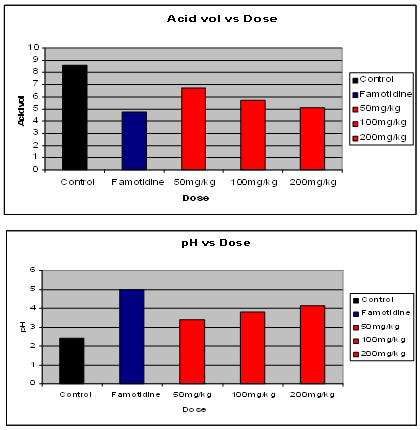 About Author:
About Author:
ATUL KABRA*, NITIN PATEL
Department of Pharmacology
G.H.B Pharmacy college,
Aniyad, Gujarat
* atul.kbr@gmail.com
ABSTRACT:
The antiulcer effect of aqueous fruit extract of Zizizphus jujuba was studied in ethanol induced ulcer model in rats. The extract dose of 50 mg/kg, 100mg/kg, 200 mg/kgproduced significant inhibition of gastric lesion induced by ethanol. The extarct reduced ulcerative lesion, gastric volume, total acidityin ethanol induced ulcer model.The result obtained suggesting that extract possesses significant antiulcer activity.
[adsense:336x280:8701650588]
Reference Id: PHARMATUTOR-ART-1334
INTRODUCTION:
Peptic ulcer and related acid peptic diseases affect up to 10 percent of the population with sufficient severity to prompt victims to seek medical attention. The most significant disorders requiring medical attention are peptic ulcer and gastro esophageal reflux disease1.
Peptic ulcers are relapsing lesions that are most often diagnosed in middle-aged to older adults, but they may first become evident in young adult life. They often appear without obvious precipitating conditions and may then, after a period of weeks to months of active disease, heal with or without therapy. Even with healing, however, the tendency to develop peptic ulcers remains, in part because of recurrent infections with H. Pylori. Although it is difficult to obtain estimates of the prevalence of active disease, autopsy studies and population surveys indicate a prevalence of 6% to 14% for men and 2% to 6% for women. The male to female ratio for duodenal ulcers is about 3:1, and for gastric ulcers about 1.5 to 2.12.
[adsense:468x15:2204050025]
Diagram of Peptic Ulcer3

Herbs helpful in antiulcer therapy4,5:
Worldwide interest in natural products as preventive and therapeutic agents has led to a greater appreciation of the rich heritage of traditional systems of medicine. Dietary and lifestyle modifications are the basis of Ayurvedic medicine, with herbal formulas rounding out therapeutic programs. Ayurvedic formulas contain many balancing herbs offering a high degree of safety and efficacy. Peptic ulcer is a major health hazard both in terms of morbidity and mortality. It occurs due to imbalance between offensive (acid-pepsin secretion, H.Pylori, bile, increased free radicals and decreased antioxidants) versus impaired mucosal resistance (mucus, bicarbonate secretion, prostaglandins, blood flow and the process of restitution and regeneration after cellular injury).
Various reports have shown that commonly used drugs for peptic ulcers such as H2 blockers (ranitidine, famotidine etc.), M1 blockers (pirenzepine, telenzepine etc.), Proton pump inhibitors (omeprozole, lanzoprozole etc.), have danger of drug interaction, adverse effect and increased incidence of relapses during ulcer therapy. Various herbal drugs like Shilajit, Ginger, Bael have been tried for their ulcer protective effects and have promising results. Therefore, the search for an ideal antiulcer drug continues and has also been extended to herbal drugs for their better protection, easy availability, low cost and toxicity.
MATERIAL AND METHODS:
Animals: Albino rats weighing 150-250 gm of either sex were used in this study after approval of the Institutional animal ethical committee, Ref: 1359/ac/10/CPCSEA.
Source: Rats used for the study were obtained from the animal house of Torrent Research Centre, Ahmedabad.
Housing: Rats were housed in groups of five in clean cages. The bedding material of the cages was changed every day. The animals were maintained under day and night cycle.
Plant material: The fruit of Ziziphus jujuba belonging to the family Rhamnaceae were collected from the local market of Godhra in December 2011. The plant was identified by Dr. Himanshu A. Pandya, Associate Professor, University School of Science, Gujarat University, Ahmedabad, Gujarat. The reference no. of the specimen is GU/Bot/2012.
Preparation of extract: Fresh fruit of Ziziphus jujuba were collected. Seeds were separated from fruits and extract of fruit was prepared by maceration method. Then, the required quantity of extract was suspended in water and aqueous used for studying antiulcer activity. This yielded about 6-8 g per 100g of fruit.
Dose Fixation6,7: As per the previous articles of Ziziphus jujuba the minimum effective dose was 50mg/kg and maximum effective dose is 200mg/kg used in rat. In present study, the dose was 50mg/kg, 100mg/kg, 200mg/kg p.o.
NOW YOU CAN ALSO PUBLISH YOUR ARTICLE ONLINE.
SUBMIT YOUR ARTICLE/PROJECT AT articles@pharmatutor.org
Subscribe to PharmaTutor Alerts by Email
FIND OUT MORE ARTICLES AT OUR DATABASE
ANTIULCER STUDIES
Ethanol induced gastric ulcer8
30 healthy albino rat of either sex weighing 150-200gm were selected for antiulcer activity. The animals were housed and fed with standard pellet diet and water ad libitum. Animals were deprived for food at least 24 hr before the start of the experiment but allowed free access of water. Coprophagy was prevented by keeping animals in cages with grating as the floor. The rats were divided in to five groups with 6 rats each. Group 1 served as induced control. Group second served reference standard drug group and received famotidine (3 mg/kg/day p.o) for 14 days. Group 3 serve as test drug group and received Ziziphus jujuba (50 mg/kg/day p.o) for 14 days. Group 4 and Group 5 received other two doses 100mg/kg/day p.o and 200 mg/kg/day p.o for the 14 days. On the day 14, ulceration was induced by the administration of 80% ethanol orally at a dose of 1ml/rat. Test or Standard is given to rat, 1 hour before the administration of ethanol. After 2 hours of ethanol administration, animals will be sacrificed by overdose of ether.
(A) Dose dependent studies: (Animal: rats)
|
SI NO |
DRUG
|
DOSE |
ROUTE OF ADMINISTRATION |
NO. OF ANIMALS |
PARAMETERS FOR STUDY |
|
1. |
Control (water) |
---------- |
Oral |
6 |
1.Ulcer index 2.Total acidity 3.Acid volume 4.pH
|
|
2. |
Standard (famotidine) |
3mg/kg |
Oral |
6 |
|
|
3. |
Fruit Extract of Ziziphus jujuba |
50mg/kg |
Oral |
6 |
|
|
4. |
Fruit extract of Ziziphus jujuba |
100mg/kg |
Oral |
6 |
|
|
5 |
Fruit Extract of Ziziphus jujube |
200mg/kg |
Oral |
6 |
|
1) Ulcer index8,9
Severity score:
0 = Normal coloured stomach
0.5 = Red colouration
1 = Spot ulcer
1.5 = Hemorrhagic streaks
2 = Ulcers ≥ 3 but ≤5
3 = ulcers > 5
Calculation:
Ulcer index was calculated as;
UI = UN+US+ UP X 10-1
Where,
UI = ulcer index
UN = average of number of ulcers per animal
US = average of severity score
UP = percentage of animals with ulcer
Determination of total acidity10
Acidity= Volume of NaOH x Normality x 100 mEq/l
0.1
RESULTS:
TABLE
Table 1-Dose dependent studies of the fruit extract of Ziziphus jujuba (FEZJ) using ethanol induced rat.
|
S.No |
Treatment |
No of animals |
Dose |
Ulcer Index |
Total Acidity (mEq/L) |
Acid Volume (ml) |
pH |
|
1 |
Control (water) |
6 |
- |
11.16±0.30 |
114.1±1.13 |
8.61±0.21 |
2.4±0.10 |
|
2 |
Famotidine |
6 |
3mg/kg |
4.33±0.42** |
59.6±0.84** |
4.75±0.33** |
5.0±0.16**
|
|
3 |
FEZJ
|
6 |
50mg/kg |
9.00±0.28 |
90.5±0.22* |
6.75±0.11* |
3.38±3.07 |
|
4 |
FEZJ
|
6 |
100mg/kg |
6.16±0.21* |
77.0±0.516* |
5.73±0.09* |
3.81±4.77** |
|
5 |
FEZJ
|
6 |
200mg/kg |
1.65±0.11** |
67.3±0.21** |
5.10±0.04** |
4.13±3.33** |
FEZJ – fruit extract of Ziziphus jujuba
**P<0.001, *P<0.05, compared with control.


NOW YOU CAN ALSO PUBLISH YOUR ARTICLE ONLINE.
SUBMIT YOUR ARTICLE/PROJECT AT articles@pharmatutor.org
Subscribe to PharmaTutor Alerts by Email
FIND OUT MORE ARTICLES AT OUR DATABASE
DISCUSSION:
Peptic ulcer is defined as disruption of the mucosal integrity of the stomach and/or duodenum leading to a local defect or excavation due to active inflammation. Despite the constant attack on the gastroduodenal mucosa by a host of noxious agents (acid, pepsin, bile acids, pancreatic enzymes, drugs, and bacteria), integrity is maintained by an intricate system that provides mucosal defense and repair. This intricate biologic system consist of mucus bicarbonate layer, surface epithelial cells and a rich submucosal micro-circulatory bed which provides bicarbonate ions to neutralize the acid generated by parietal cell secretion of hydrochloric acid. Moreover, this micro-circulatory bed provides an adequate supply of micronutrients and oxygen while removing toxic metabolic by products75.
Various studies suggested that changes in gastric motility may play a role in the development and prevention of experimental gastric lesions76,77,78.
Relaxation of circular muscle may protect the gastric mucosa through flattening of the folds. This will increase the mucosal surface area exposed to necrotizing agents and reduce the volume of the irritant on the rugal crests. Such an action has been postulated to play a role in the cytoprotective effect of prostaglandins79.
The present study has been done to evaluate the antiulcer effect of fruit extract of Ziziphus jujuba on ethanol induced dose dependent ulcers. The results obtained from the present study have been shown that fruit extract of Ziziphus jujuba possesses antiulcer effect on ethanol induced ulcers. In ethanol and stress induced model, there is decrease in ulcer index, total acidity, total volume of gastric secretion, and increase in pH of gastric secretion when compared with control. In the present study Famotidine has been used as a standard.
Ethanol induced gastric ulcer:
Ethanol serves as a most common ulcerogenic agent and when given intragastrically to rats it produces severe gastric hemorrhagic erosions80. The genesis of ethanol induced gastric lesions is multifactorial with the depletion of gastric wall mucus content as one of the involved factors81 and this damage induced by ethanol may be due to mucosal leukotriene release82. Mucosal blood flow has also been attributed to be an important factor in the damage caused by alcohol and is modulated by prostaglandin83. Submucosal venular constriction by ethanol and eventual injury is caused due to perturbations of superficial mucosal cells,82 notably the mucosal mast cells leading to release of vasoactive mediators including histamine, that cause damage to gastric mucosa84. Ethanol-induced damage to the gastric mucosa is associated with a significant production of free radicals leading to an increased lipid peroxidation and damage to the cell and cell membranes. Accumulation of activated neutrophils in the gastric mucosa may be a source of free radicals82.
In the present study, Famotidine used as a standard drug. Famotidine is a H2 receptor blocker, is capable of reducing over 90% of basal, food stimulated and nocturnal secretion of gastric acid, stimulated by histamine, gastrin, cholinomimetic drugs and vagal stimulation85. Famotidine exerts its antisecretory effect by inhibiting the histamine induced c-AMP dependent pathway86. Famotidine also increase certain mucus component of gastric mucus in patients with duodenal ulcer87.
Total acidity indicates that how much acid is present in the gastric secretion. It is a major aggressive factor which produce ulcer. Gastric secretion is under vagal control and over activity of vagus also contributes to ulcer formation14. Vagal stimulation releases acetylcholine that act directly on muscarinic receptors on parietal cells and secretes hydrochloric acid through a Ca++ dependent pathway89.
On ethanol treatment, the mucosal mast cells leading to release of vasoactive mediators including histamine84. Histamine is thought to stimulate the production of cyclic AMP by activating the enzyme adenyl cyclase which causes activation of gastric proton pump and release of hydrogen ions. FEZJ treatment showed decrease in the total acidity of the gastric secretion.
Serum protein consists of albumin and globulin. In the peptic ulcer the total protein content of serum or gastric juice is increased. This could be due to leakage of plasma protein in to the gastric juice or serum with weakening of the mucosal resistance/barrier of the gastric mucosa90. After treatment with FEZJ there was a significant decrease in protein content of gastric juice which suggest that it might be primarily decrease the leakage of plasma protein in to the gastric juice with strengthening of the mucosal barrier and increase in its resistance to the damaging effect of aggressive factors.
Acid volume is a volume (ml) of acid present in the gastric secretion which contains HCl, pepsinogen, mucus, bicarbonates, intrinsic factor and proteins. Volume of acid secretion is also an important factor in the production of ulcer due to exposure of unprotected lumen of the stomach to the accumulating acid91. FEZJ treatment showed decrease in the acid volume of the gastric secretion.
Higher pH indicates a lower concentration of the hydrogen ion. The hydrogen ion is a major aggressive factor involved in the genesis of ulcer and gastric damage92. FEZJ treatment showed an increase in pH of the gastric contents. This directly indicates that the FEZJ lowers the chances of ulcer and has a protective action upon the gastric mucosa.
CONCLUSION:
The present study has been done to evaluate the antiulcer effect of FEZJ on ethanol induced ulcer models at various doses. The results obtained from the present study have shown that FEZJ possesses antiulcer effect on ethanol induced ulcers.
Pre-treatment with FEZJ particularly at a dose of 200mg/kg, 100mg/kg and 50mg/kg decreases ulcer index, total acidity, total volume of acid secretion and total protein and increase in pH and glutathione content when compared with control.
All these observation imply that the FEZJ could be regarded as a favourable antiulcerogen which could be attributed to its content of flavonoids and mucilage.
REFERENCES:
1.Burks TF. Principles of Pharmacology. United States of America: International Thomson publishing Inc; 1995. pp 1063.
2.Kumar V, Abbas KA, Fausto N. Robbins and Cotran Pathologic Basis of Disease. 7th ed. New Delhi: Elsevier Inc; 2004. pp 817.
3.Peptic ulcer diagram. Available from: wanderiner.blogspot.com
4.Chaturvedi A, Kumar MM, Bhawani G, Chaturvedi H, Kumar M, Goel KR. Effect of ethanolic extract of Eugenia Jambolana seeds on gastric ulceration and secretion in rats. Indian J Physiol Pharmacol 2007; 51(2): 131-140.
5.Nadkarni KM. Indian Materia Medica. 2nd ed. Bombay: Popular Prakashan; 1976. Vol 2 pp 394-95.
6.Nasir Rosool and Zubair Muhammad, “Antioxidant Activity of Various Extracts and Organic Fraction of Ziziphus jujuba”, International Journal of Phytomedicine, March 2011, pp. 346-352.
7.Taati Majid, Moghadasi Mehrnoush, “Protective effect of Ziziphus jujuba fruit extract against ethanol-induced hippocampal oxidative stress and spatial memory impairment in rats”, Journal of Medicinal Plant Research Vol.5, March 2011,pp 915-921.
8.Robert A. Cytoprotection by prostaglandins. Gastroenterol 1979; 77: 761-67.
9.Kulkarni SK. Hand Book of Experimental Pharmacology. 3rd ed. New Delhi: Vallabh Prakashan; 2002. pp. 149.
10.Mukherjee KL. Medical Laboratory Technology. New Delhi: Tata McGraw-Hill; 1989. vol 3 pp. 1086-88.
NOW YOU CAN ALSO PUBLISH YOUR ARTICLE ONLINE.
SUBMIT YOUR ARTICLE/PROJECT AT articles@pharmatutor.org
Subscribe to PharmaTutor Alerts by Email
FIND OUT MORE ARTICLES AT OUR DATABASE










